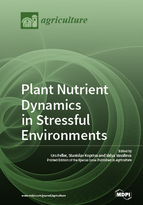Plant Nutrient Dynamics in Stressful Environments
A special issue of Agriculture (ISSN 2077-0472).
Deadline for manuscript submissions: closed (30 November 2017) | Viewed by 85204
Special Issue Editors
Interests: abiotic stress impacts; climate change; drought and heat responses; transport of nutrients and pollutants via xylem and phloem; photosynthesis under abiotic stress; rubisco activase properties
Special Issues, Collections and Topics in MDPI journals
Interests: regulatory mechanisms of nutrient uptake and assimilation; control of nutrient homeostasis; role of microorganisms in plant nutrition; sulfur metabolism; metabolic fluxes; integration of nutrient assimilation in general plant metabolism
Special Issues, Collections and Topics in MDPI journals
Special Issue Information
Dear Colleagues,
Abiotic and biotic stresses can strongly influence plant nutrient dynamics by affecting nutrient availability in the soil, uptake, assimilation, transport and accumulation within the plant. Such effects become more and more important in the course of global climate change. Combinations of stresses may cause more complex effects and must be considered besides individual stresses (e.g., beneficial effects on aphids and other animal pests on drought-stressed plants, improved solubility of some heavy metals in waterlogged soil).
This Special Issue intends to summarize the recent progress in the elucidation of stress effects on the nutrition of plants and on the quality of harvested crops. All types of articles, original research, opinions and reviews that provide new insights into the effects of various stresses and the mechanisms involved in the stress responses are welcome. Experimental studies and theoretical approaches referring to the molecular, cellular, organ or whole plant level may be considered. Understanding the interaction between stress and nutrition is highly relevant for modern agriculture in order to ensure high yields and high quality of plant products in stressful environments. The following list of stresses gives some examples and is not exhaustive:
- High salt concentration in soil solution
- Heavy metals in the soil
- Air pollution (e.g., ozone)
- Drought
- Waterlogging
- Heat
- Low temperature
- Microbial pests
- Animal pests
- Competition with other plants (e.g., with weeds)
Plant nutrient availability depends on nutrient contents in the soil and on processes prior to the acquisition of macro- and micronutrients by plants. Some nutrients may be insolubilized at the root surface or in the root apoplast before reaching a translocator embedded in the plasmalemma of root cells. After the uptake into root cells, nutrients may be subjected to assimilatory processes (e.g., for nitrogen, sulfur) and/or to the transfer from the cytosol to other subcellular compartments. The transfer of nutrients to the central cylinder and the release into the xylem are important steps for the transport from the roots to the shoot via the transpiration stream. During the acropetal transport, nutrient ions may be removed from the xylem sap and accumulate in the stem or may be loaded into the phloem. Xylem-to-phloem transfer is important, since the two long-distance transport systems are directed to other organs. Nitrogen and sulfur are not necessarily assimilated in the root system, but may also be transported to shoot organs in inorganic form and then assimilated there. After fulfilling functions in active shoot organs nutrients may be remobilized during senescence and redistributed via the phloem to other sinks within the same plant (e.g., expanding leaves, maturing fruits). All the processes summarized here may be affected by abiotic and biotic stresses and must therefore be considered for this Special Issue:
- Processes in the soil affecting nutrient availability for plants (e.g., solubilization or insolubilzation of nutrients, soil water potential, redox processes in the soil solution)
- Interaction of plants with soil microorganisms
- Nutrient acquisition and root architecture
- Processes at the root surface and in the root apoplast
- Uptake of nutrients across a membrane into the root symplast
- Compartmentation of nutrients on the organ, tissue and subcellular level
- Assimilatory processes
- Transport of nutrients to the central cylinder and release into the root xylem
- Transport of nutrients via xylem and phloem including interactions between the two long-distance transport systems in stems, petioles or leaf veins
- Effects of nutrient disorders on physiological processes in various organs
- Remobilization of nutrients from senescing plant parts and redistribution to sinks via the phloem
- Nutrient dynamics in fruits and seeds, quality of plant products
Particular emphasis of the Special Issue should be made on summarizing approaches that improve the potential of crop plants to cope with biotic and abiotic stresses, on identifying possible targets for breeding or genotype selection and on suggesting modifications in agricultural techniques to reduce the negative influence of stress.
Prof. em. Urs Feller
Prof. Valya Vassileva
Prof. Stanislav Kopriva
Guest Editors
Manuscript Submission Information
Manuscripts should be submitted online at www.mdpi.com by registering and logging in to this website. Once you are registered, click here to go to the submission form. Manuscripts can be submitted until the deadline. All submissions that pass pre-check are peer-reviewed. Accepted papers will be published continuously in the journal (as soon as accepted) and will be listed together on the special issue website. Research articles, review articles as well as short communications are invited. For planned papers, a title and short abstract (about 100 words) can be sent to the Editorial Office for announcement on this website.
Submitted manuscripts should not have been published previously, nor be under consideration for publication elsewhere (except conference proceedings papers). All manuscripts are thoroughly refereed through a single-blind peer-review process. A guide for authors and other relevant information for submission of manuscripts is available on the Instructions for Authors page. Agriculture is an international peer-reviewed open access monthly journal published by MDPI.
Please visit the Instructions for Authors page before submitting a manuscript. The Article Processing Charge (APC) for publication in this open access journal is 2600 CHF (Swiss Francs). Submitted papers should be well formatted and use good English. Authors may use MDPI's English editing service prior to publication or during author revisions.
Keywords
- Abiotic stress
- Biotic stress
- Nutrient availability in soil
- Nutrient uptake
- Nutrient assimilation
- Transport via xylem and phloem
- Nutrient redistribution
- Senescence
- Nutrient contents in harvested plant products
- Pollution








